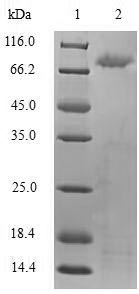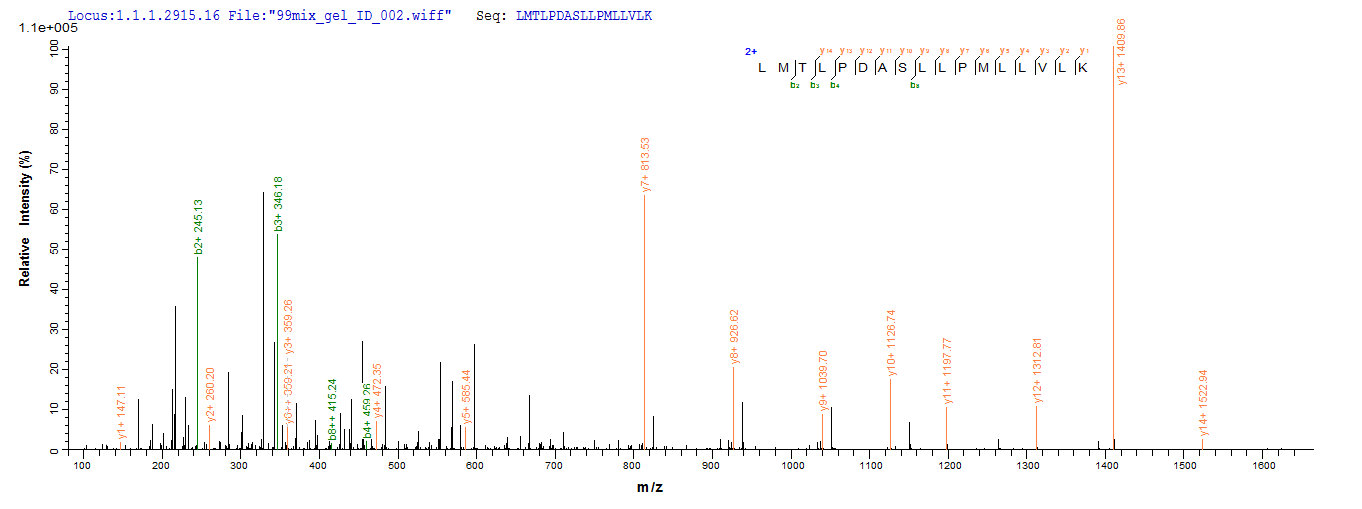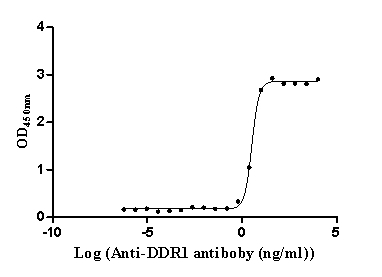Recombinant Human Toll-like receptor 2 (TLR2), partial
In Stock-
货号:CSB-EP023601HU1
-
规格:¥1344
-
图片:
-
(Tris-Glycine gel) Discontinuous SDS-PAGE (reduced) with 5% enrichment gel and 15% separation gel.
-
Based on the SEQUEST from database of E.coli host and target protein, the LC-MS/MS Analysis result of CSB-EP023601HU1 could indicate that this peptide derived from E.coli-expressed Homo sapiens (Human) TLR2.
-
Based on the SEQUEST from database of E.coli host and target protein, the LC-MS/MS Analysis result of CSB-EP023601HU1 could indicate that this peptide derived from E.coli-expressed Homo sapiens (Human) TLR2.
-
-
其他:
产品详情
-
纯度:Greater than 90% as determined by SDS-PAGE.
-
基因名:
-
Uniprot No.:
-
别名:CD282; CD282 antigen; TIL 4; TIL4; TLR 2; TLR2; TLR2_HUMAN; Toll like receptor 2; Toll like receptor 2 precursor; Toll-like receptor 2; Toll/interleukin 1 receptor like 4; Toll/interleukin 1 receptor like protein 4; Toll/interleukin receptor like protein 4; Toll/interleukin-1 receptor-like protein 4
-
种属:Homo sapiens (Human)
-
蛋白长度:Partial
-
来源:E.coli
-
分子量:80.4kDa
-
表达区域:19-588aa
-
氨基酸序列KEESSNQASLSCDRNGICKGSSGSLNSIPSGLTEAVKSLDLSNNRITYISNSDLQRCVNLQALVLTSNGINTIEEDSFSSLGSLEHLDLSYNYLSNLSSSWFKPLSSLTFLNLLGNPYKTLGETSLFSHLTKLQILRVGNMDTFTKIQRKDFAGLTFLEELEIDASDLQSYEPKSLKSIQNVSHLILHMKQHILLLEIFVDVTSSVECLELRDTDLDTFHFSELSTGETNSLIKKFTFRNVKITDESLFQVMKLLNQISGLLELEFDDCTLNGVGNFRASDNDRVIDPGKVETLTIRRLHIPRFYLFYDLSTLYSLTERVKRITVENSKVFLVPCLLSQHLKSLEYLDLSENLMVEEYLKNSACEDAWPSLQTLILRQNHLASLEKTGETLLTLKNLTNIDISKNSFHSMPETCQWPEKMKYLNLSSTRIHSVTGCIPKTLEILDVSNNNLNLFSLNLPQLKELYISRNKLMTLPDASLLPMLLVLKISRNAITTFSKEQLDSFHTLKTLEAGGNNFICSCEFLSFTQEQQALAKVLIDWPANYLCDSPSHVRGQQVQDVRLSVSECHRT
Note: The complete sequence including tag sequence, target protein sequence and linker sequence could be provided upon request. -
蛋白标签:N-terminal 6xHis-SUMO-tagged
-
产品提供形式:Liquid or Lyophilized powder
Note: We will preferentially ship the format that we have in stock, however, if you have any special requirement for the format, please remark your requirement when placing the order, we will prepare according to your demand. -
缓冲液:Tris-based buffer,50% glycerol
-
储存条件:Store at -20°C/-80°C upon receipt, aliquoting is necessary for mutiple use. Avoid repeated freeze-thaw cycles.
-
保质期:The shelf life is related to many factors, storage state, buffer ingredients, storage temperature and the stability of the protein itself.
Generally, the shelf life of liquid form is 6 months at -20°C/-80°C. The shelf life of lyophilized form is 12 months at -20°C/-80°C. -
货期:3-7 business days
-
注意事项:Repeated freezing and thawing is not recommended. Store working aliquots at 4°C for up to one week.
-
产品描述:
The recombinant Human TLR2 protein is encoded by the gene of TLR2 (19-588aa). The gene of TLR2 was cloned in a system (E.coli) that supported the expression of TLR2. Modification of TLR2 by recombinant DNA technology could lead to the expression of the target protein. The protein was fused with N-terminal 6xHis-SUMO tag in the production. The purity is 90% determined by SDS-PAGE.
TLR2 is a protein coding gene that encodes Toll-like receptor 2. According to some research, TLR2 may have the following features.
TLR2 and TLR4 have different roles in recognizing the cell wall components of Gram-negative and Gram-positive bacteria. The crystal structure of TLR1-TLR2 heterodimer induced by triacylated lipopeptide. Toll-like receptor 2 (TLR2) and TLR4 activate human dendritic cells to varying degrees. Kidney-related TLR2 mediates renal ischemia/reperfusion injury. TLR9 regulates Th1 response and cooperates with TLR2 to mediate the best resistance to Mycobacterium tuberculosis. TLR2 is expressed on activated T cells and is a cost-stimulating receptor. Factors produced by cancer cells activate bone marrow cells through TLR2 to stimulate metastasis. TIRAP plays an important role in activating the signal cascade shared by TLR2 and TLR4. -
Datasheet & COA:Please contact us to get it.
相关产品
靶点详情
-
功能:Cooperates with LY96 to mediate the innate immune response to bacterial lipoproteins and other microbial cell wall components. Cooperates with TLR1 or TLR6 to mediate the innate immune response to bacterial lipoproteins or lipopeptides. Acts via MYD88 and TRAF6, leading to NF-kappa-B activation, cytokine secretion and the inflammatory response. May also activate immune cells and promote apoptosis in response to the lipid moiety of lipoproteins. Recognizes mycoplasmal macrophage-activating lipopeptide-2kD (MALP-2), soluble tuberculosis factor (STF), phenol-soluble modulin (PSM) and B.burgdorferi outer surface protein A lipoprotein (OspA-L) cooperatively with TLR6. Stimulation of monocytes in vitro with M.tuberculosis PstS1 induces p38 MAPK and ERK1/2 activation primarily via this receptor, but also partially via TLR4. MAPK activation in response to bacterial peptidoglycan also occurs via this receptor. Acts as a receptor for M.tuberculosis lipoproteins LprA, LprG, LpqH and PstS1, some lipoproteins are dependent on other coreceptors (TLR1, CD14 and/or CD36); the lipoproteins act as agonists to modulate antigen presenting cell functions in response to the pathogen. M.tuberculosis HSP70 (dnaK) but not HSP65 (groEL-2) acts via this protein to stimulate NF-kappa-B expression. Recognizes M.tuberculosis major T-antigen EsxA (ESAT-6) which inhibits downstream MYD88-dependent signaling (shown in mouse). Forms activation clusters composed of several receptors depending on the ligand, these clusters trigger signaling from the cell surface and subsequently are targeted to the Golgi in a lipid-raft dependent pathway. Forms the cluster TLR2:TLR6:CD14:CD36 in response to diacylated lipopeptides and TLR2:TLR1:CD14 in response to triacylated lipopeptides. Required for normal uptake of M.tuberculosis, a process that is inhibited by M.tuberculosis LppM.
-
基因功能参考文献:
- TLR2 protein has a role in introduction of IL-6, IL-8, and TNF-alpha cytokines into human amniotic epithelial cells by Ureaplasma urealyticum-derived lipid-associated membrane proteins PMID: 30070088
- No significant association between TLR2 + 2477G/A polymorphism and bacterial meningitis risk were found under allele contrast, recessive genetic model. PMID: 29457581
- The detection of higher frequencies of the TLR2, TLR4 and/or TLR9 polymorphisms in colorectal cancer (CRC) patients compared with the control groups highlight the role of these polymorphism in CRC development and cancer progression PMID: 29883450
- These findings further validated the involvement of P. acnes in the pathology of intervertebral disc degeneration (IVDD) and provided evidence that P. acnes-induced apoptosis of NPCs via the TLR2/JNK pathway is likely responsible for the pathology of IVDD. PMID: 29323102
- Live Faecalibacterium prausnitzii, an abundant obligate anaerobe of the colonic microbiota, induced higher TLR2 and TLR2/6 activation than the dead bacterium. PMID: 29112296
- the results of the present study showed significantly higher mRNA expression levels for TLR2 180days post-transplantation in the graft dysfunction group compared to well functioning graft group PMID: 29452169
- Finding suggest that genetic variation in TLR2 (rs3804099) is associated with severity and prognosis of bacterial meningitis in Chinese children. PMID: 28202935
- The findings show that the expression of TLR2, TLR4 and TLR9, and hypoxia markers HIF-1alpha and CAIX is abnormal in pancreatic intraepithelial neoplasia suggesting that both the innate immunity activation and hypoxia response are involved in early pancreatic carcinogenesis. PMID: 30357962
- Results provide evidence regarding the association of the rs3804099 in the TLR2 gene with H. pylori infection and Peptic Ulcer. The rs3804099 may affect vulnerability to H. pylori infection, particularly to CagA+ strains of bacteria. PMID: 29755012
- Studied association of vitamin D receptor (VDR) single nucleotide polymorphisms (SNPs) and promoter region deletions of toll like receptor 2 (TLR2) with genetic predisposition for pulmonary tuberculosis (PTB) in India communities. Results show that the BsmI and FokI polymorphisms of the VDR gene are significantly associated with an increased risk of PTB. PMID: 29727015
- OLP changed the expression profile of miR-155 and miR-19a, which in turn directly affected the production of eNOS and TLR2, respectively. In addition, by synergistically inducing an imbalance between Th1 and Th2, the simultaneous deregulation of miR-155/eNOS and miR-19a/TLR2 was responsible for an elevated risk of OLP. PMID: 29813046
- Results suggested that TRL2 contributes to the development of atherosclerosis by regulating lipid accumulation, plaque formation and serum inflammatory cytokines level. PMID: 28815701
- Data suggest that serum levels of soluble TLR2 are down-regulated in subjects with type 2 diabetes as compared to control subjects; levels of soluble TLR4 are similar in both groups of subjects. PMID: 29160122
- our current findings demonstrate that TLR2 expression is upregulated in human colorectal cancer (CRC) tumor tissue and indicates poor prognosis. We show that TLR2 can promote CRC cellular proliferation concomitant with the upregulation of anti-apoptotic genes BCL2A1, WISP1 and BIRC3 subsequent to the activation of the PI3K/Akt and NF-kappaB signaling pathways. PMID: 29689497
- Genotyping was performed to detect -196 to -174 del polymorphism and G2258A SNP (Arg753Gln, rs5743708) in TLR2 gene in patients with pulmonary tuberculosis and healthy controls. We could not find a significant difference in allelic or genotypic frequencies of two TLR2 polymorphisms between cases and controls. PMID: 29675696
- Low TLR2 expression is associated with pancreatic ductal adenocarcinoma. PMID: 30246618
- Our results suggest that the R753Q polymorphism of the TLR-2 gene may be involved in the pathogenesis of mastocytosis. PMID: 29909409
- TLR2 SNPs were not associated with acute graft rejection in kidney transplant recipients. PMID: 28411360
- Heterozygote Arg753Gln TLR2 gene polymorphism was found in 9 of 86 pulmonary tuberculosis subjects (10.5%) but none in the latent TB group. Arg753Gln polymorphism of TLR2 gene is a risk factor for active pulmonary tuberculosis while Arg677Trp polymorphism is not. PMID: 29686176
- TLR2 Arg677Trp polymorphism and H. pylori infection may play crucial roles in peptic ulcer development respectively in north of Iran. PMID: 28844484
- CD44 regulated TLR2 responses in human macrophages, whereby a reduction in CD44 levels or engagement of CD44 by its ligand (HA) or a CD44-specific Ab reduced NF-kappaB translocation and downstream proinflammatory cytokine production. PMID: 29196459
- TLR2 up-regulation and TLR3 down-regulation occur in doxorubicin-treated patients who develop heart dysfunction. This may suggest a predictive role of TLR2-TLR3 imbalance in doxorubicin-induced heart failure. PMID: 29959987
- a crucial role of TLR2 depends on agonist release by bacterial surfactants, is reported. PMID: 27470911
- host gene variants in TLR2 signaling pathways were modestly associated with cervical A. vaginae in women with clinical pelvic inflammatory disease PMID: 29286178
- TLR2 may affect inflammatory reaction in coronary artery endothelial cells by introducing pro-inflammatory molecules like MyD88, pIRAK-1, and pNF-kappaB. PMID: 28986953
- A moderately truncated lipooligosaccharides (LOS) structure did not interfere with M. marinum invasion. However, a deeper shortening of the LOS structure was associated with increased entry of M. marinum into host cells and increased elimination of the bacilli by the macrophages. These effects were dependent on Toll-like receptor 2. PMID: 29183333
- Our results evidenced the deleterious effect of the Hap7 haplotype ([Del]-T-[M or L]) in the incidence rate in severe bacterial infections in pediatric SCA. This haplotype presents both the -196 to -174 22-bp deletion, localized in the TLR2 first untranslated exon, and the SNP rs4696480 T allele, in the TLR2 promoter, that have previously been associated with susceptibility to infections of various etiologies. PMID: 28667380
- A positive association between TLR2 polymorphisms and hepatitis B infection in a Han Chinese population. PMID: 29320990
- important factor in placental anti-parasite defenses, involved in the local secretion of cytokines but also in regulating, at least partially, the trophoblast turnover PMID: 29208238
- Mycobacterium tuberculosis protein MymA is a TLR2 agonist that upregulates signaling via MyD88 and NF-kappaB in macrophages to stimulate the release of proinflammatory cytokines PMID: 28802400
- Data showed strong interactions of toll-like receptors TLR2 and 4 associated with Leishmania(V.) braziliensis, while toll-like receptor TLR9, in contrast, a strong interaction with Leishmania (L.) amazonensis. PMID: 29543867
- Lsa21 is a potent TLR2 and TLR4 agonist that induces strong innate response and may play important role in Leptospira pathogenesis PMID: 27996041
- No significant association between polymorphisms of TLR2 and TLR4 with pulmonary tuberculosis or latent tuberculosis infection was detected. PMID: 29924447
- ionizing radiation increased the cell surface expressions of TLR2 and TLR4 through reactive oxygen species-mediated JNK activation. PMID: 28369600
- the TLR2-196 to -174 Ins/Del polymorphism is a risk factor for HIV-1 transmission in HIV-1 infected North Indian individuals. PMID: 28730622
- TLR-2 transcript is significantly up-regulated in the tissue of intracranial aneurysm. PMID: 29066233
- TLR2 signaling is important to control the fungal burden in the vaginal tract. These finding provide new evidence about the role of this innate receptor during vulvovaginal candidiasis. PMID: 28911197
- Variant A of the SNP TLR2-rs4696480 polymorphism significantly increased the risk of OSCC (p = 0.03) and OLL (p = 0.02). PMID: 28624699
- Expression of TLR2 and TLR4 may be affected by the type of bacteria that are present in the gut. PMID: 29085211
- Identification of TLR2/TLR6 signalling lactic acid bacteria for supporting immune regulation. PMID: 27708357
- Studied associations of 12 single nucleotide polymorphisms (SNPs) within toll like receptor genes (TLR2, TLR3, TLR4, and TLR9) and genetic predisposition to neonatal severe hepatitis. Found certain SNPS were associated with prognosis of neonatal severe hepatitis. PMID: 28703296
- High Expressions of TLR2 is associated with degenerative knee osteoarthritis. PMID: 28418842
- The TLR2 (R753Q and A-16934T) single nucleotide polymorphisms are not associated with atopic dermatitis in a group of Turkish patients PMID: 28443596
- results implicate neuronal TLR2 expression in human Parkinson's disease pathogenesis PMID: 27888296
- this study signifies that TLR2 adaptor molecules are necessary for the proper production of cytokines, chemokines and pro-labour mediators after TLR ligation PMID: 28844021
- results indicate that although live B. anthracis and S. aureus express abundant TLR2 ligands, highly-purified PGN from either bacterial source is not recognized by TLR2. PMID: 29474374
- TLR2 and BGN contribute to sterile inflammation and infertility in man. PMID: 27849015
- Data show that infecting unencapsulated E. faecalis cps2 is a stronger stimulator for toll like receptor 2 (TLR2) and interleukin-1beta (IL-1beta) mRNAs, but not for inducible nitric oxide synthase (iNOS) mRNA. PMID: 28800779
- In the majority of cosmonauts increases in endogenous ligands were followed by growth in the number of both monocytes and granulocytes that express TLR2 and TLR4. PMID: 29553590
- These data suggest that TLR2 activation is involved in the induction of IL-15 production by primary Sjogren's syndrome salivary gland epithelial cells and promotes inflammation through NF-kappaB activation. PMID: 27260411
显示更多
收起更多
-
亚细胞定位:Membrane; Single-pass type I membrane protein. Cytoplasmic vesicle, phagosome membrane; Single-pass type I membrane protein. Membrane raft.
-
蛋白家族:Toll-like receptor family
-
组织特异性:Highly expressed in peripheral blood leukocytes, in particular in monocytes, in bone marrow, lymph node and in spleen. Also detected in lung and in fetal liver. Levels are low in other tissues.
-
数据库链接:
HGNC: 11848
OMIM: 246300
KEGG: hsa:7097
STRING: 9606.ENSP00000260010
UniGene: Hs.519033
Most popular with customers
-
Recombinant Human E3 ubiquitin-protein ligase ZNRF3 (ZNRF3), partial (Active)
Express system: Mammalian cell
Species: Homo sapiens (Human)
-
Recombinant Human Epithelial discoidin domain-containing receptor 1 (DDR1), partial (Active)
Express system: Mammalian cell
Species: Homo sapiens (Human)
-
Recombinant Human Microtubule-associated protein tau (MAPT) (Active)
Express system: Mammalian cell
Species: Homo sapiens (Human)
-
Recombinant Human Cell adhesion molecule 1 (CADM1), partial (Active)
Express system: Mammalian cell
Species: Homo sapiens (Human)
-
Recombinant Human Interleukin-2 receptor subunit alpha (IL2RA), partial (Active)
Express system: Mammalian cell
Species: Homo sapiens (Human)
-
Recombinant Human Interleukin-2 (IL2) (Active)
Express system: Mammalian cell
Species: Homo sapiens (Human)
-
Recombinant Human Serotransferrin(TF) (Active)
Express system: Mammalian cell
Species: Homo sapiens (Human)
-
Recombinant Human Interleukin-12 receptor subunit beta-1(IL12RB1),partial (Active)
Express system: Mammalian cell
Species: Homo sapiens (Human)







-AC1.jpg)















